Introduction to OOPs Interview Questions
If you’re preparing for an interview in the year 2024 and are expecting questions on Object-Oriented Programming (OOPs), you’ve come to the right place. In this blog post, we will cover some commonly asked OOPs interview questions and provide detailed answers to help you ace your interview.
1. What is Object-Oriented Programming?
Object-Oriented Programming (OOP) is a programming paradigm that organizes code into objects, which are instances of classes. It focuses on the concepts of encapsulation, inheritance, and polymorphism to create reusable and modular code.
Object-Oriented Programming (OOP) is a programming paradigm that revolutionized software development by introducing a more modular and organized approach. At its core, OOPs centre around the concept of objects, which represent real-world entities and encapsulate both data and the operations that can be performed on that data. The four main principles of OOPs are: encapsulation, inheritance, polymorphism, and abstraction. form the foundation for designing robust and scalable software systems.
2. What are the main principles of OOP?
The main principles of OOP are:
- Encapsulation: Encapsulating data and methods within objects to hide implementation details and provide a clean interface.
- Inheritance: Allowing a class to inherit properties and methods from another class, promoting code reusability.
- Polymorphism: The ability of objects to take on different forms or behaviours based on the context.
- Abstraction: Simplifying complex systems by breaking them down into smaller, more manageable units.
3. What is the difference between a class and an object?
A class is a blueprint or template for creating objects, while an object is an instance of a class. In simpler terms, a class defines the properties and behaviours that an object can have, while an object represents a specific instance of that class.
4. Explain the concept of inheritance in OOP.
Inheritance is a mechanism in OOP where a class inherits properties and methods from another class. The class that inherits is called the child class or subclass, while the class being inherited from is called the parent class or superclass. Inheritance promotes code reusability and allows for the creation of specialized classes based on existing ones.
5. What is the difference between method overloading and method overriding?
Method overloading occurs when multiple methods in a class have the same name but different parameters. The compiler determines which method to call based on the number and types of arguments passed.
Method overriding, on the other hand, happens when a subclass provides its own implementation of a method that is already defined in its parent class. The method in the subclass must have the same name, return type, and parameters as the method in the parent class.
6. What is the purpose of the ‘final’ keyword in Java?
The ‘final’ keyword in Java is used to restrict the modification of classes, methods, and variables. When applied to a class, it prevents inheritance, meaning that the class cannot be extended. When used with a method, it prevents overriding, ensuring that the method’s implementation cannot be changed in any subclass. Finally, when applied to a variable, it makes it a constant, meaning its value cannot be modified once assigned.
7. What is the concept of polymorphism?
Polymorphism refers to the ability of objects to take on different forms or behaviours based on the context. In OOP, polymorphism is achieved through method overriding and method overloading. Method overriding allows a subclass to provide its own implementation of a method inherited from its parent class, while method overloading allows multiple methods with the same name but different parameters to coexist within a class.
8. What is a Class?
A class is a blueprint or template for creating objects. It defines properties (attributes) and behaviours (methods) that the objects of the class will have.
9. Explain the concepts of the inheritance?
Inheritance is a mechanism where a new class (subclass/derived class) inherits properties and behaviours from an existing class (superclass/base class). It promotes code reusability and establishes a relationship between classes.
10. Differentiate between abstraction and Encapsulation?
- Abstraction: It involves hiding the complex implementation details and showing only the essential features of an object.
- Encapsulation: It involves bundling the data and methods that operate on the data into a single unit, i.e., a class, providing control over the access to the data.
11. Explain the concepts of Method Overriding?
Method Overriding occurs when a subclass provides a specific implementation for a method that is already defined in its superclass. It allows a subclass to provide a specialized version of a method that is already defined in its superclass.
12. What is an abstract Class?
An abstract class is a class that cannot be instantiated and may contain abstract methods (methods without a body). Subclasses must provide concrete implementations for these abstract methods.
13. What are some major object oriented programming language?
The programming language that follow the concepts of object oriented programming paradigm or OOPs are know as object oriented programming languages. Some of the major object oriented programming languages are:
- Java
- C++
- JavaScript
- Python
- PHP
14. Describe the difference between composition and inheritance?
- Inheritance: It is an “is-a” relationship, where a class inherits properties and behaviours from another class.
- Composition: It is a “has-a” relationship, where a class contains an instance of another class as a member. It allows for better flexibility and code organization.
15. What is an object in oops?
In object-oriented programming (OOPs), an object is a fundamental concept that represents a real-world entity or a conceptual item. An object is an instance of a class, and a class is a blueprint or template that defines the properties (attributes) and behaviours (methods) common to all objects of that type.
Here’s a some of the key components related to objects in OOPs:
- Class:
- A class is a blueprint or a template that defines the attributes and behaviours that an object of that class will have.
- It serves as a model for creating objects.
- Example: A “Car” class may define attributes like colour, model, and behaviours like start, stop, and accelerate.
- Object:
- An object is an instance of a class, created based on the blueprint provided by the class.
- It represents a specific instance of a real-world entity or a conceptual item.
- Example: An object of the “Car” class could be an actual car, such as a red Ford Mustang.
- Attributes (Properties):
- Attributes are the characteristics or properties of an object.
- They define the state of an object.
- Example: For a “Person” class, attributes could include name, age, and address.
- Behaviours (Methods):
- Behaviours are the actions or operations that an object can perform.
- They define the functionality of an object.
- Example: Methods of a “Dog” class might include bark(), eat(), and sleep().
16. Types of Polymorphisms?
Polymorphism in object-oriented programming refers to the ability of a single interface to take on multiple forms. There are two main types of polymorphism: compile-time polymorphism and runtime polymorphism
1. Compile-Time Polymorphism (Static Binding or Method Overloading):

Compile-time polymorphism occurs during the compilation phase of the program. It involves multiple methods with the same name within the same class, but with different parameter lists (different types or a different number of parameters).
2. Runtime Polymorphism (Dynamic Binding or Method Overriding):
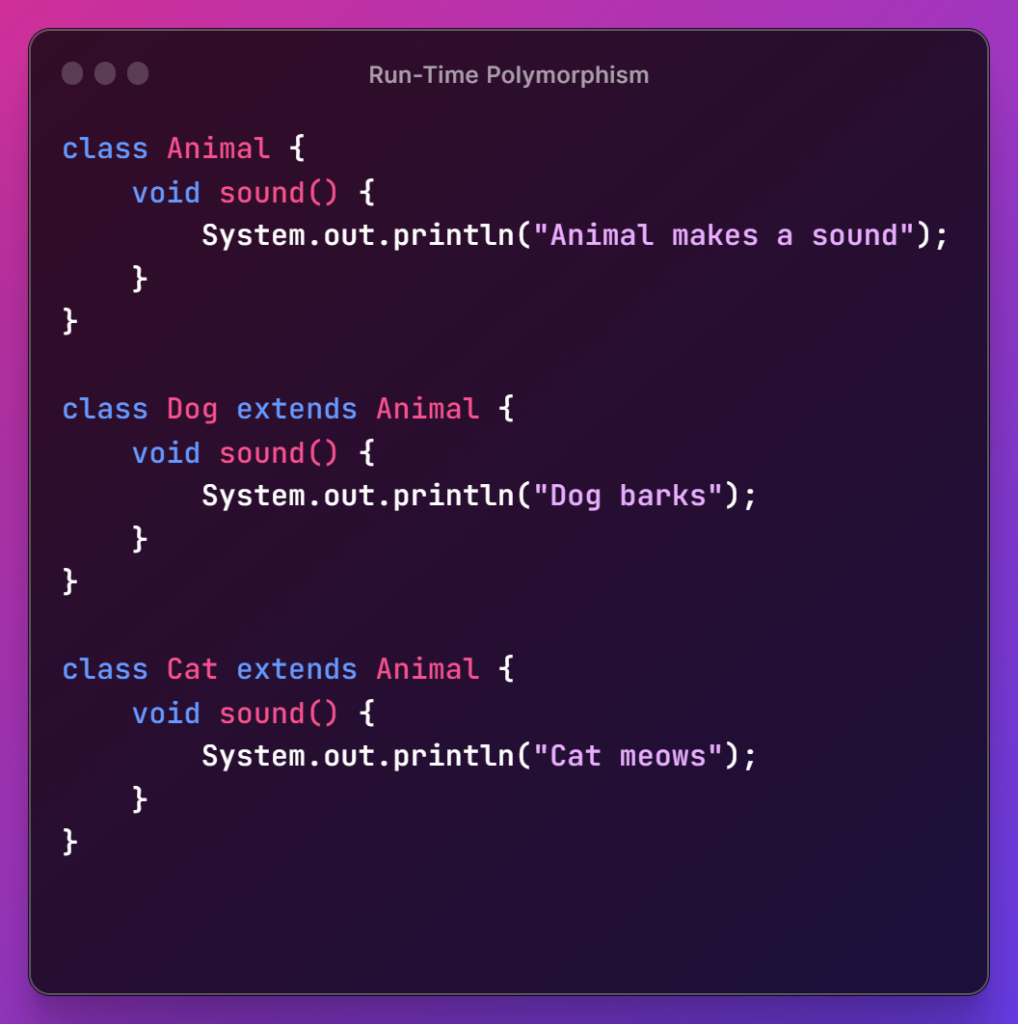
Runtime polymorphism occurs during the execution phase of the program. It involves a base class and a derived class, where the derived class provides a specific implementation of a method that is already defined in the base class. The decision on which method to call is made at runtime.
17. What is constructor?
A constructor in object-oriented programming is a special type of method or function that is automatically called when an object is created. It has the same name as the class to which it belongs and is used to initialize the object’s state.
Key characteristics of constructors:
- Name: The constructor has the same name as the class.
- Initialization: It is used to initialize the object’s attributes or properties, providing initial values to the object when it is created.
- Invocation: Constructors are automatically invoked when an object is created. They are called using the
newkeyword in languages like Java. - Return Type: Constructors do not have a return type. They implicitly return an instance of the class.
Here is a simple example in Java:
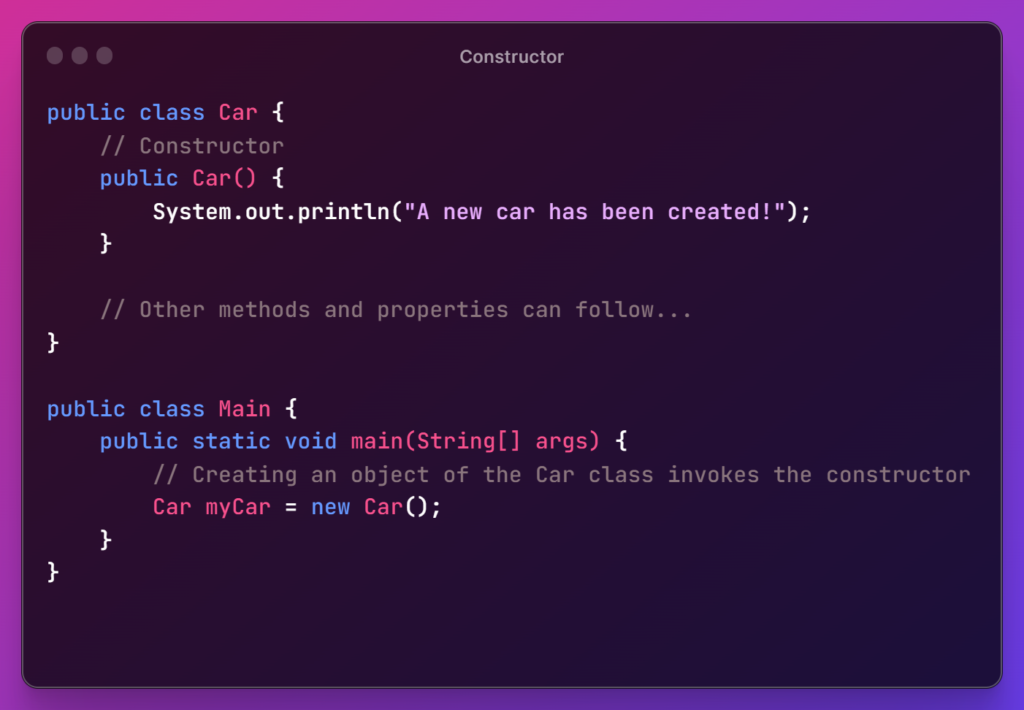
18. What is Destructor?
19. What are the various types of inheritance?
Inheritance is a fundamental concept in object-oriented programming that allows a new class (subclass or derived class) to inherit attributes and behaviors from an existing class (base class or superclass). There are several types of inheritance, each serving different purposes in class hierarchy design:
Single Inheritance:
- A class inherits from only one base class.
- It forms a simple and straightforward hierarchy.
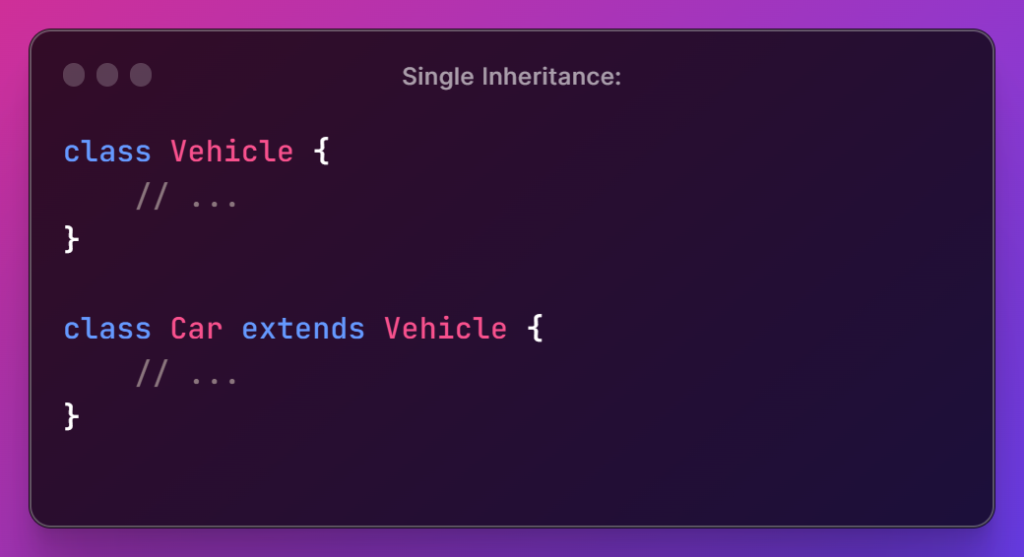
Multiple Inheritance:
- A class inherits from more than one base class.
- Can lead to the “diamond problem” where ambiguity arises if two base classes have a common ancestor.
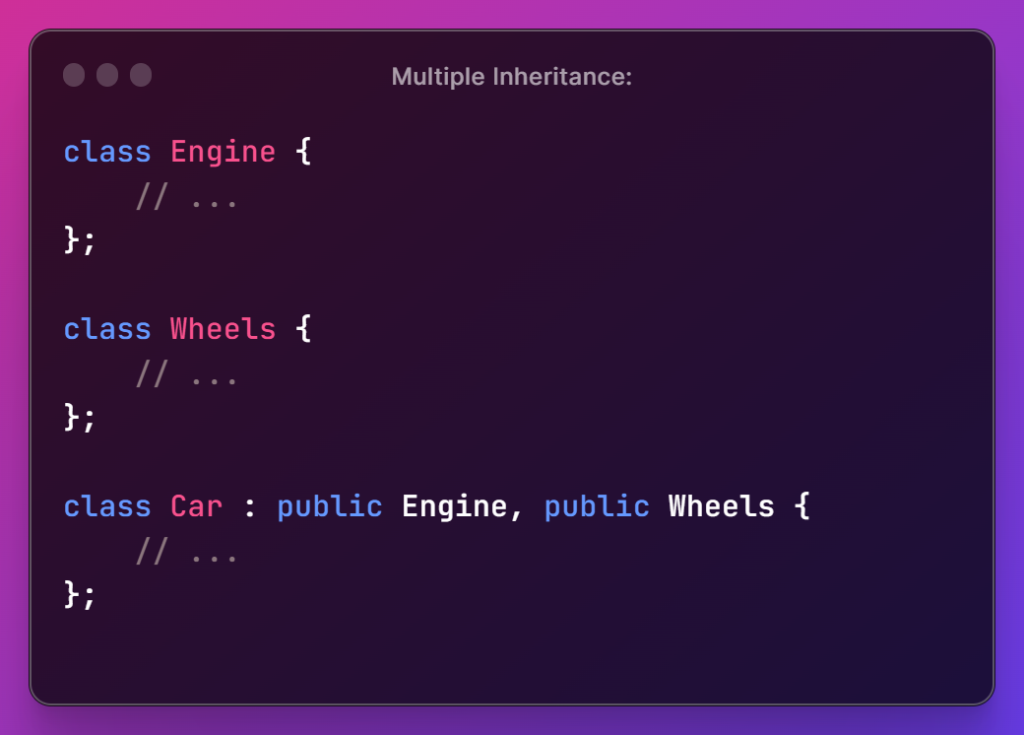
Multilevel Inheritance:
- A class is derived from another class, and then another class is derived from it, forming a chain of inheritance.
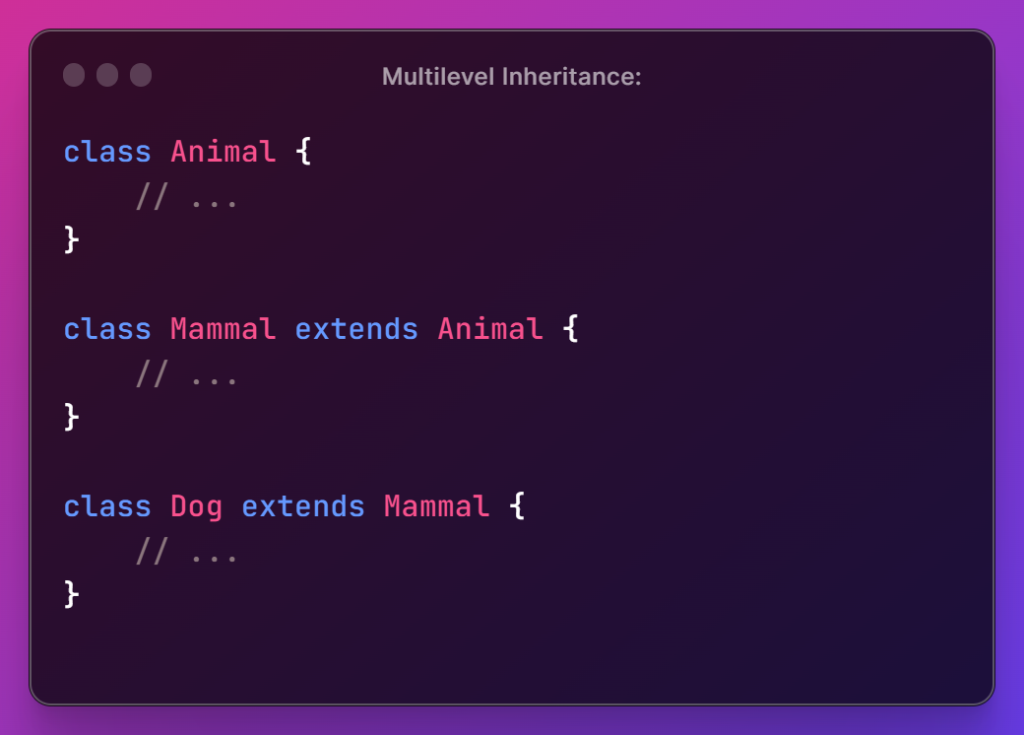
Hierarchical Inheritance:
- Multiple classes are derived from a single base class.
- Forms a tree-like structure.
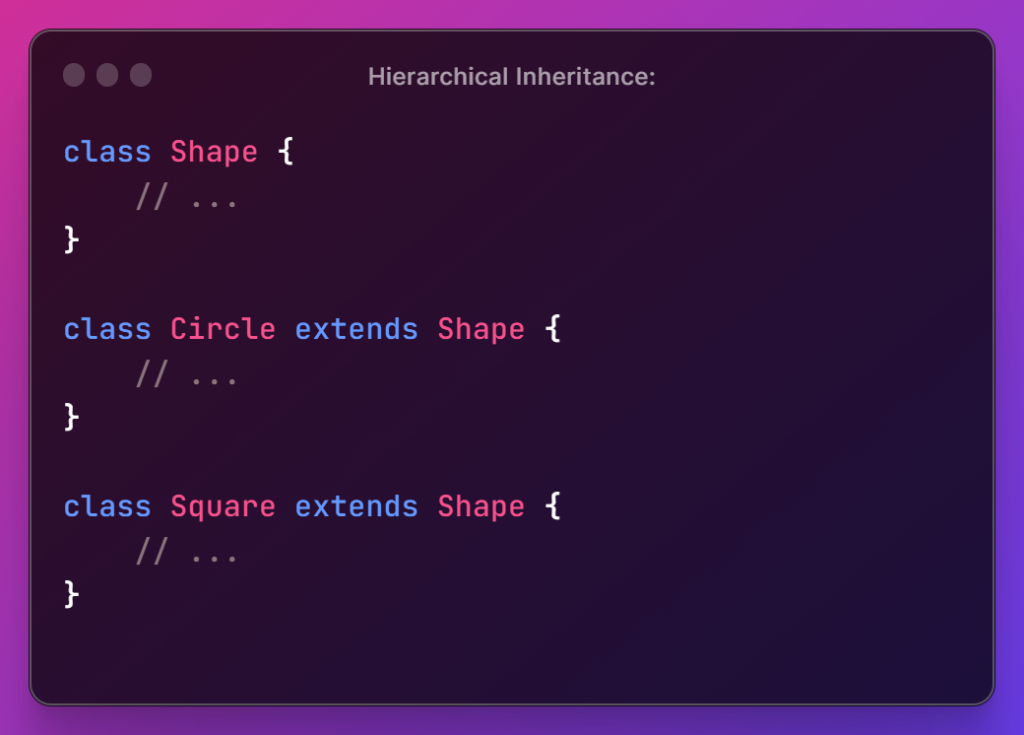
Hybrid Inheritance:
- A combination of multiple types of inheritance within a single program.
- Often involves using multiple inheritance and single inheritance together.
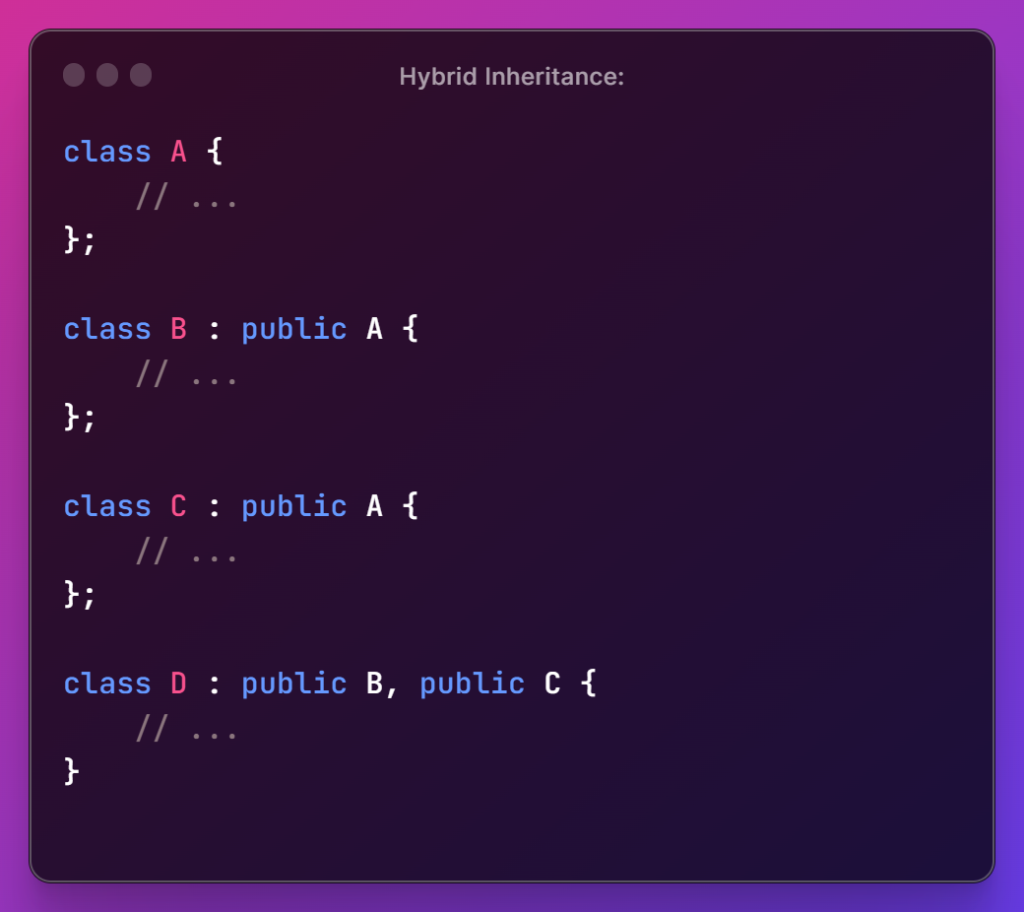
Interface Inheritance (Java and C#):
- In some languages, like Java and C#, there’s a concept of interface inheritance.
- An interface defines a contract that multiple classes can implement.
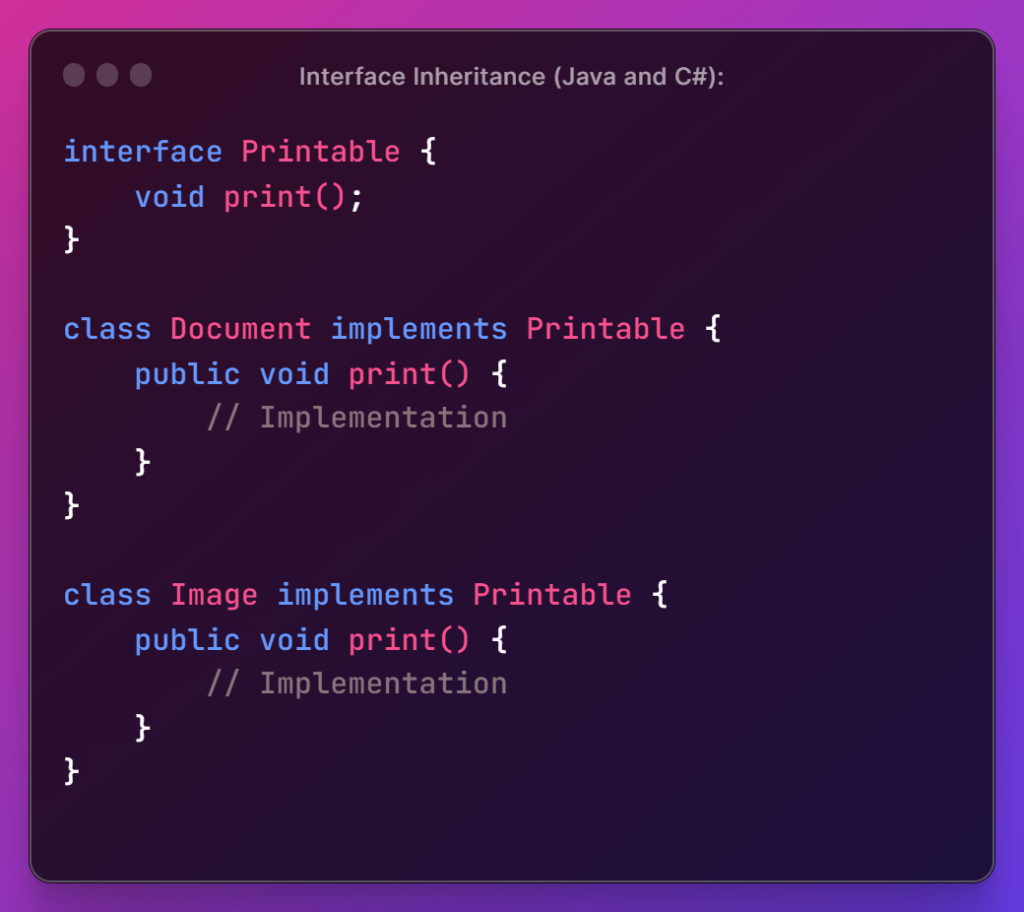
20. What is different between Overloading and overriding?
Overloading and overriding are both concepts in object-oriented programming related to methods in classes. They serve different purposes and have distinct characteristics:
- Method Overloading:
- Definition: Method overloading occurs when a class has multiple methods with the same name but different parameters (number, type, or order).
- Key Points:
- Parameters must differ in type, number, or both.
- Return types or access modifiers do not play a role in overloading.
- Method Overriding:
- Definition: Method overriding occurs when a subclass provides a specific implementation for a method that is already defined in its superclass.
- Key Points:
- The method in the subclass must have the same signature (name, return type, and parameters) as the method in the superclass.
- Used for achieving runtime polymorphism.
21. What is meant by Exception Handling?
Exception handling is a mechanism in object-oriented programming (OOP) that deals with runtime errors or exceptional situations that may occur during the execution of a program. In OOP languages, such as Java, C++, and C#, exception handling is typically implemented using the following constructs:
Try-Catch Blocks:
- A
tryblock encloses the code that might generate an exception. - A
catchblock follows thetryblock and specifies the type of exception it can handle. - If an exception occurs in the
tryblock, the correspondingcatchblock is executed to handle the exception.
Throw Statement:
- The
throwstatement is used to explicitly throw an exception in a program. - It is typically used when a specific condition is met, and the program cannot proceed further.
Finally Block:
- A
finallyblock is used to specify code that will be executed whether an exception occurs or not. - It is often used for clean-up activities, such as closing files or releasing resources.
Custom Exception Classes:
- Developers can create custom exception classes by extending existing exception classes.
- Custom exceptions allow for more specific and meaningful exception handling.
22. What is the difference between composition and inheritance?
Composition and inheritance are both mechanisms for code reuse in OOP, but they differ in their approach. Inheritance promotes an “is-a” relationship, where a subclass is a type of its superclass. Composition, on the other hand, promotes a “has-a” relationship, where an object contains other objects as part of its structure. Inheritance can lead to a more rigid and tightly coupled codebase, while composition allows for greater flexibility and code modularity.
Conclusion
By familiarizing yourself with these OOPs interview questions and their answers, you’ll be well-prepared to tackle any OOPs-related questions that may come your way during an interview in 2024. Remember to practice implementing OOP concepts in code and gain hands-on experience to further enhance your understanding. Good luck with your interview!
You might also Like:
System Administrator Interview Questions in 2024
SEO interview questions job interview in 2024


1 thought on “OOPs Interview Questions and Answers 2024”
Comments are closed.